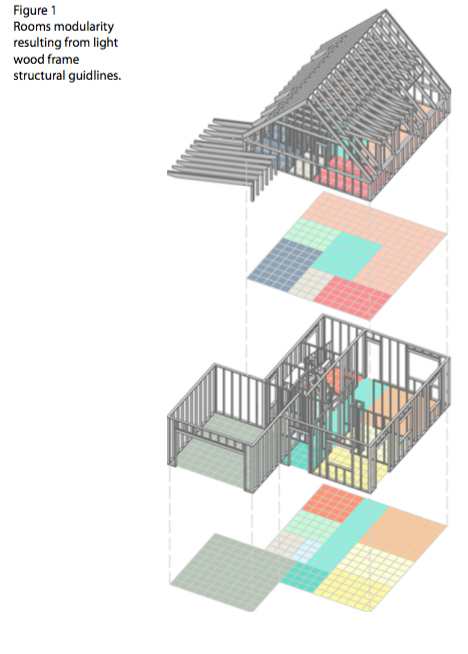by Krystian Kwiecinski, Filipe Santos, Ana de Almeida, Bruno Taborda, Sara Eloy.


This paper will focus on an undergoing research that aims at developing a system that allows hous- ing future inhabitants to participate in the design of their house by using mass-customization design (Kwieciński and Slyk 2014). The proposed system is based on shape grammars and will allow future own- ers to acquire houses that fit their needs while simul- taneously complying to a language of design (Stiny 1980). Such a system will enable to deliver design solutions with quality (Eloy et al. s.d.) and at afford- able prices improving satisfaction of clients. The sys- tem encodes knowledge on housing design princi- ples (types and sizes of rooms and preferable connec- tions) as well as in the timber construction technique that underlies the shape composition principles.
To make the system available for future inhabitants a computer implementation is being developed so that it could be made available online or at the hous- ing construction company. The design tool will: i) de- liver design solutions answering the client’s’ require- ments based on a design grammar therefore main- taining a language of design, ii) be feasible to be used by non designers (e.g. clients, sales staff of a con- struction company). With the aim of finding a good technical solution to satisfy users’ needs two strate- gies of implementation are being developed simul- taneously and in close collaboration. One is based in shape grammars supplemented with processes and the other based in genetic algorithms.
Research in mass-customized design using shape grammars have been developed over the years and several shape grammars have addressed the housing problem and the need to make available de- sign systems that respond to the inhabitants needs (Duarte 2001; Colakoglu 2005; Benros et al. 2011; Eloy 2012; Coimbra and Romão 2013). The main dif- ficulty to fully use these systems in design practice is the delay of the computer implementation of ar- chitectural design processes, namely by the use of shape grammar logics. Computerized design tools that offer design alternatives supporting the design ways of thinking and working are still rare.
Current systems allow some aspects of genera- tion of shape and are based on a built-in drawing ed- itor, e.g. Rabo-de-Bacalhau grammar tool (Strobbe 2015) or in links to a CAD software, e.g. Grappa (Grasl 2012) for Revit (McKay et al. 2012). These systems are essentially academic based and not yet aiming at being used in the real design scenario. Design ap- plications like Flemming (1987) Queen Anne Houses tool, Li (2002) Yingzao fashi grammar, Grasl (2012) Grappa tool and Ligler and Economou (2015) Ent- elechy Grammar are systems that allow to develop designs according to languages of past styles. Those tools are used specially in an historical and design un- derstanding perspective and not as tools to design new solutions for architecture problems. Other im- plementations like Strobbe (2014) Rabo-de-Bacalhau grammar tool allow to generate new design solutions that can then be used by the house owners to do their refurbishment. The goal of the presented research is to deliver such a tool that can deliver designs able to be immediately used as a design project to build a house.
Catalogues of house designs are very popular in several countries. Future owners are provided a cat- alogue of standardized solutions for them to choose but those solutions are restricted to a small number of changes and the act of choosing is based on look- ing to all solutions and not to the ones that may re- spond to the clients need. In this research we aim at looking for systems that allow users to play with a house design tool allowing them to find the best fit house to their own personal wishes.